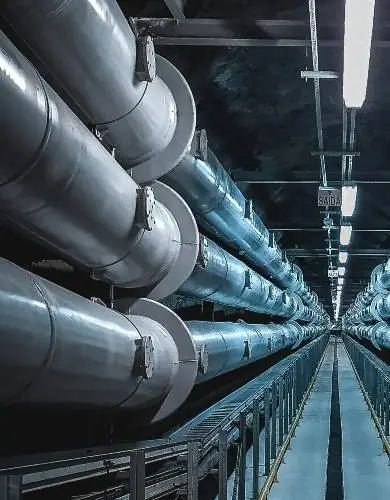How sewage is used to power Britain
Britain has over 7,000 sewage treatment works, all producing sewage sludge, a solid organic by-product of wastewater treatment.
In the past, sewage sludge was routinely disposed of in British landfills, where it decomposed and produced harmful greenhouse gases.
Today, sewage sludge is recognised as a valuable biomass source that can generate green biogas, renewable electricity, and organic fertilisers.
This guide explains how sewage sludge helps offset some of the harmful environmental impacts of the water industry. We begin with a quick explanation of how sewage treatment plants work.
How sewage treatment plants work
One of the principal roles of the British water industry is to collect raw sewage from homes and trade effluent from businesses through a network of sewer pipes.
The basic function of sewage treatment works is to separate all the organic solids (sewage sludge) from water that can be returned safely into rivers or the sea.
Here’s a brief overview of what happens to sewage arriving at a treatment works:
Step 1. Screening
The first step is to remove large objects, such as nappies, wet wipes, and cotton buds, from wastewater that could damage downstream equipment.
The screening step uses large screens and racks that act as giant sieves to trap solid items.
Step 2. Sedimentation
After the initial screening, the next step is to separate human waste using large settlement tanks.
Solid organic waste (sludge) sinks to the bottom of the tank, and large arms or scrapers separate it from the wastewater.
Step 3. Aeration
Wastewater is pumped into ‘aeration lanes,’ where air is added to the water to encourage microbial growth. The microorganisms break down the remaining organic matter, removing the pathogens present in the water.
Step 4. Discharge
Following treatment, wastewater is in a condition where it can be safely returned to the environment.
Sewage treatment facilities pump treated sewage into the nearest river, stream, or the sea, where it joins the water cycle.
Step 5. Sewage sludge
All organic matter removed from wastewater in the processes above is called sewage sludge.
Sewage sludge produced by sewage treatment plants is valuable because it is rich in biochemical energy and key nutrients.
The sewage sludge generated by Britain’s water companies is used in three ways, which we’ll explain further in this article:
💡 Unfortunately, a massive opportunity for sewage sludge collection is currently being missed due to the water industry’s habit of dumping raw sewage directly into rivers.
Generating biogas from sewage
In this section, we explain how sewage treatment works in Britain can produce biogas and explore the different ways this can be used as a renewable energy source.
How anaerobic digesters produce biogas
Anaerobic digester systems are large, airtight tanks designed to create an oxygen-free environment in which microorganisms can break down waste and generate biogas.
Some sewage treatment works have an anaerobic digester on site, while some water companies transport sludge to dedicated industrial-scale anaerobic digestion facilities.
Here’s an overview of the process that produces biogas from sewage sludge:
- Feeding the digester – Sewage sludge is pumped into a sealed, airtight anaerobic digester tank.
- Heating and mixing – The digester is heated and stirred to provide optimal conditions for microbial growth.
- Organic breakdown – Microbes convert organic matter into simpler molecules, producing biogas as a by-product.
- Biogas collection – Methane-rich biogas is captured and extracted from the top of the tank.
- Digestate collection – The remaining sludge is nutrient-rich and safe to be used as an agricultural fertiliser, as the microbes will also have killed all pathogens.
💡 Visit our sister site, Commercial Waste Quotes, for a full explanation of how anaerobic digestion works.
In the next section, we’ll explain how the biogas produced by anaerobic digestion is used as a renewable energy source.
Renewable electricity generation
Biogas can be burned directly in an on-site Combined Heat and Power (CHP) unit to generate electricity.
As of January 2025, 173 sewage works in Britain generate electricity on-site, with an overall output capacity of 227 MW. This is equivalent to the massive Pen y Cymoedd 76-turbine wind farm development.
The electricity generated by the on-site Combined Heat and Power unit is exported to the local grid using a Corporate PPA or the Smart Export Guarantee scheme.
💡 Combined Heat and Power units at sewage treatment works generate REGO certificates, which is the system of certification Ofgem uses to guarantee renewable energy generation.
Green gas generation
An alternative pathway is to purify biogas to remove carbon dioxide, water, and impurities, leaving biomethane (98% methane), similar in quality to the natural gas used by business gas suppliers in Britain.
Green biomethane produced is either:
- Injected into the local gas grid to supply nearby homes and businesses.
- Compressed into liquified natural gas, which can be used in Green Bus public transport schemes.
Biomethane production is supported by the Green Gas Support Scheme, which incentivises the injection of renewable gas into the national grid.
Using sewage as biomass fuel
Sewage sludge can be converted into valuable biomass fuel at central facilities, such as Daldowie in Scotland, which processes 35% of all sewage sludge generated by Scottish Water.
A central facility uses centrifuges (a machine that separates liquids and solids by spinning them rapidly in a circular motion) to remove any remaining water from the sewage sludge.
The remaining solid sludge is heated and dried into biomass pellets, a concentrated source of biomass energy.
Biomass pellets are used at power plants, such as the Drax Power Station, where they are incinerated to generate renewable electricity.
Using sewage as a fertiliser
Treated sewage sludge contains key nutrients needed by plants and crops, specifically:
- Nitrogen (N): Promotes leafy growth.
- Phosphorus (P): Essential for root development and flowering.
- Potassium (K): Improves overall plant health and resistance to disease.
- Micronutrients: Includes trace elements like zinc, copper, and magnesium.
- Organic matter: Improves soil structure, water retention, and microbial activity.
To be safely used in agriculture, it is necessary to neutralise the pathogens present in sewage sludge either through:
- Lime stabilisation – Adding chemicals to the sludge to make it less acidic, killing off pathogens and reducing odours.
- Thermal drying – Drying the sludge at high temperatures to kill pathogens and reduce moisture content, converting the sludge into slow-release fertiliser granules.
The treated sludge is then applied to farmland as a cheaper alternative to synthetic fertilisers, helping to encourage crop growth.
💡 The runoff of fertilisers into British rivers poses a significant threat to the health of British waterways.

